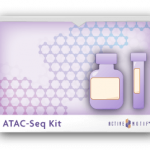CUT&Tag-IT™ Assay Kit Overview Cleavage Under Targets and Tagmentation (CUT&Tag) is a method to investigate genomic localization of histone modifications and some transcription factors that reveals interactions between proteins and DNA or identifies DNA binding sites for proteins of interest. Unlike MNase-Seq or ATAC-Seq methods that target open chromatin and are therefore dependent on chromatin […]
- Chromatin
ATAC-Seq Kit
Analyze open chromatin regions at genome-wide scale. ATAC-Seq is a rapid assay that allows analysis of epigenetic profiles across the genome by identification of regions that have open or accessible chromatin states. Because of the assay’s speed, simplicity, and applicability to a wide range of sample types, ATAC-Seq has become a commonly-used epigenetic assay, and […]
Low Cell ChIP-Seq Optimization Module
Maximize retainment of limited ChIP-Seq samples When performing ChIP-Seq on limited samples, maximizing retainment of the already precious sample is key. Active Motif’s Low Cell Optimization Module enables Low Cell ChIP-Seq Kit users to monitor sample retainment as they progress through the protocol. This first-of-its-kind module includes “positive control” samples and antibody, as well as […]
Nu.Q™ H3.1
Determine levels of H3.1-containing, circulating cell-free nucleosomes Active Motif’s Nu.Q™ H3.1 Assay Kit is designed for the detection of levels of Histone H3.1-containing, circulating cell-free nucleosomes (cf-nucleosomes) in human serum in a high-throughput format. Histone H3.1, or the canonical form of Histone H3, is deposited during DNA replication and possibly also during repair. Study of […]
ChIP-IT® FFPE II
Perform ChIP on FFPE samples Formalin-fixed paraffin-embedded (FFPE) clinical samples are a valuable resource for retrospective research. However, working with FFPE samples presents a challenge for epigenetics techniques such as ChIP. Active Motif has leveraged its epigenetics expertise to develop commercially available kits to enable ChIP from FFPE tissue for use in Next Generation Sequencing […]


